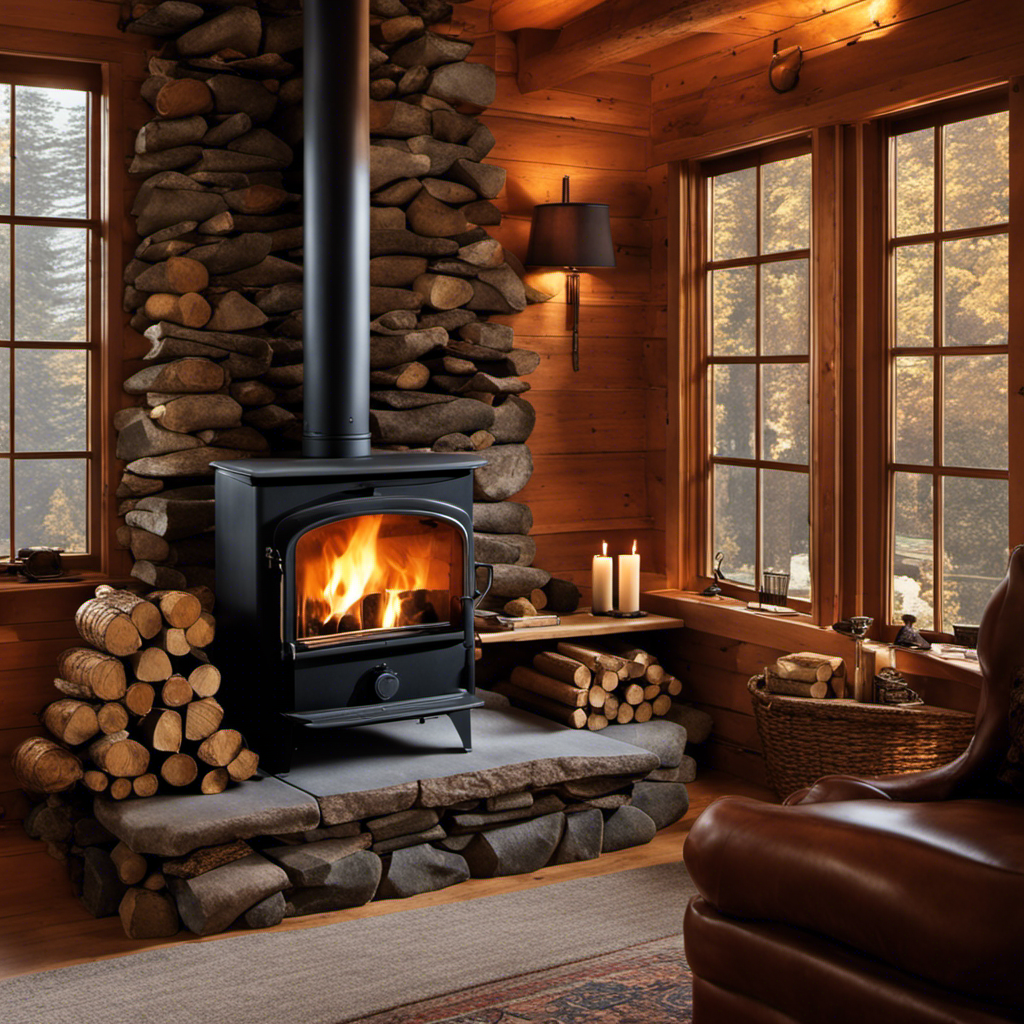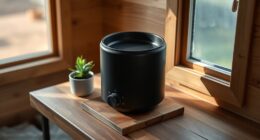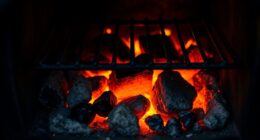Did you know choosing the right type of wood for burning can greatly affect how efficient and powerful your fire is? With so many options available, it can be challenging to determine the best wood for your needs.
In this article, I will provide you with valuable information on the different wood types, their moisture content, energy content, and environmental considerations. By the end, you’ll have a clear understanding of what wood to use for indoor fireplaces and outdoor pits, as well as which ones to avoid.
Let’s dive in!
Key Takeaways
- Hardwoods burn slower and produce more heat than softwoods.
- Low moisture content is important for energy efficiency and sustainable sourcing.
- Properly seasoned wood ensures more efficient and effective fires.
- Consider using wood certified by organizations like the Forest Stewardship Council (FSC) for sustainable sourcing.
Hardwoods Vs. Softwoods
Hardwoods burn slower and produce more heat than softwoods. This is because hardwoods have a higher density and contain more energy per unit volume. They are perfect for creating a long-lasting, cozy fire in your fireplace or wood-burning stove.
One key factor to consider when using hardwoods is the moisture content. It is important to ensure that your firewood has a moisture content of around 20% or less for optimal efficiency. Wet or green wood can be difficult to ignite and will produce less heat.
To achieve the desired moisture content, it is recommended to store your firewood in a well-ventilated area for at least six months to a year. This allows the wood to dry out properly and ensures a more efficient and enjoyable fire.
Speaking of moisture content and firewood…
Moisture Content and Firewood
To ensure an efficient and effective fire, you’ll want to make sure the moisture content of your firewood is low. Here are four reasons why low moisture content is important for energy efficiency and sustainable sourcing:
- Increased heat output: Dry firewood burns hotter and produces more heat, allowing you to warm your space more effectively.
- Reduced smoke and emissions: Wet wood produces more smoke and releases harmful pollutants into the air. Dry wood burns cleaner and is better for the environment.
- Longer burn time: Dry firewood burns slower and lasts longer, reducing the need for frequent refueling and maximizing energy efficiency.
- Decreased creosote buildup: Wet wood can lead to excessive creosote buildup in your chimney, increasing the risk of chimney fires. Dry wood minimizes this risk and ensures safer operation.
Now, let’s explore the energy content of different wood types and how it affects your fire.
Energy Content of Different Wood Types
Dry firewood burns hotter and produces more heat, making it a better choice for efficient and effective fires.
When it comes to the energy content of different wood types, hardwoods and softwoods offer distinct advantages. Hardwoods, such as oak and maple, have a higher density and contain more energy per unit volume. They are ideal for long-lasting burns, providing a steady and sustained heat output.
On the other hand, softwoods like pine and fir have a lower density and burn more quickly. They are perfect for generating quick heat, making them a great choice for starting a fire or warming up a room in a short amount of time.
However, it is important to note that using properly seasoned wood is crucial for optimal burning efficiency and reducing the risk of creosote buildup in your chimney.
The Importance of Properly Seasoned Wood
Using properly seasoned firewood ensures more efficient and effective fires. The importance of proper storage and using seasoned wood cannot be overstated.
Seasoned firewood refers to wood that has been dried for an extended period, typically for at least six months to a year. This process allows the wood to reach an optimal moisture content of around 15-20%.
Seasoned wood has several benefits when it comes to burning. Firstly, it produces more heat compared to green or unseasoned wood. This means that you can get a hotter and longer-lasting fire, providing more warmth and comfort. Additionally, seasoned wood burns cleaner and produces less smoke and creosote buildup, reducing the risk of chimney fires.
Transitioning to the next section, it is important to consider the environmental impact of wood burning.
Environmental Considerations for Wood Burning
When it comes to environmental considerations for wood burning, you should be mindful of the emissions released into the air. Not all types of wood burn with the same level of energy efficiency or have the same impact on the environment. Here are some key factors to consider:
- Energy Efficiency:
- Hardwoods like oak and maple are denser and burn longer, providing more heat per log.
- Softwoods like pine and fir burn faster and are better for quick bursts of heat.
- Sustainable Sourcing:
- Look for wood that is certified by organizations like the Forest Stewardship Council (FSC), ensuring it comes from responsibly managed forests.
- Consider using reclaimed or recycled wood as an eco-friendly option.
Considering these factors, you can make choices that are both energy efficient and environmentally friendly. Now, let’s dive into the best wood for indoor fireplaces.
Best Wood for Indoor Fireplaces
When it comes to choosing the best wood for indoor fireplaces, there are a few key points to consider.
First, there is the debate between hardwood and softwood. Hardwood, such as oak or maple, tends to burn longer and produce more heat, while softwood, like pine or cedar, ignites quickly but burns faster.
Secondly, the moisture content of the wood is crucial. It’s important to use seasoned wood with a moisture content of around 20% or less to ensure efficient combustion and minimize smoke production.
Lastly, for those looking to add a pleasant fragrance to their indoor fire, aromatic woods like cherry or apple can be a great choice.
Hardwood Vs. Softwood
If you want a longer and hotter burn, hardwood is the best choice compared to softwood. Hardwood, such as oak or maple, is denser and contains more energy per unit volume than softwood, like pine or spruce. This means that hardwood logs will provide a longer-lasting and more intense heat, making them ideal for heating larger spaces or for those who want a cozy, long-lasting fire. On the other hand, softwood burns faster and produces less heat, making it better suited for quick and efficient fires, like in a campfire or for cooking. Here’s a comparison table to better understand the benefits of hardwood and the disadvantages of softwood:
| Hardwood Benefits | Softwood Disadvantages |
|---|---|
| Denser | Burns faster |
| Longer burn time | Less heat produced |
| Provides intense heat | May require more logs |
Speaking of wood burning, moisture content matters.
Moisture Content Matters
To ensure an efficient and clean burn, you should make sure the moisture content of your firewood is below 20%. Burning wood with high moisture content not only reduces energy efficiency but also has a significant environmental impact. Here are some reasons why moisture content matters when it comes to burning firewood:
- Energy Efficiency: Wet firewood requires more energy to burn off the excess moisture, reducing the overall heat output. Dry firewood, on the other hand, burns more efficiently, providing more heat for your home.
- Reduced Smoke and Emissions: Wet firewood produces more smoke and harmful emissions, contributing to air pollution and negatively impacting air quality. Dry firewood burns cleaner, minimizing environmental harm.
- Longer Burn Time: Dry firewood burns longer and provides a sustained heat source, ensuring you get the most out of your firewood supply.
- Less Creosote Build-up: Burning wet firewood leads to increased creosote build-up in your chimney, which can be a fire hazard. Dry firewood produces less creosote, reducing the risk of chimney fires.
Aromatic Woods for Fragrance
You can enhance the ambiance of your home by using aromatic woods that release pleasant fragrances when burned. Aromatic woods, such as apple, cherry, and hickory, are not only great for adding a delightful scent to your living space, but they also have practical uses in cooking.
These woods are highly sought after for grilling and smoking food due to their unique flavors that infuse into the meat, adding depth and complexity to dishes. The benefits of using aromatic woods for smoking food are numerous. They provide a natural, smoky flavor that can’t be replicated with other cooking methods. Plus, they create a wonderful aroma that can make your outdoor cooking experience even more enjoyable.
Now, let’s transition into the discussion about the best wood for outdoor fire pits and campfires.
Best Wood for Outdoor Fire Pits and Campfires
When it comes to choosing the best wood for outdoor fire pits and campfires, there are a few key factors to consider.
First, the debate between hardwood and softwood is worth exploring. Hardwoods, such as oak and hickory, tend to burn longer and produce more heat, while softwoods, like pine and fir, ignite quickly but burn faster.
Another important aspect is the seasoning and moisture content of the wood. Properly seasoned wood with low moisture content will burn more efficiently and produce less smoke.
Lastly, if you’re looking to create a cozy and aromatic ambiance, certain woods like cedar and apple can add a pleasant scent to your outdoor fire experience.
Hardwood Vs. Softwood
Hardwood burns longer and produces more heat than softwood. This is due to the higher density and lower moisture content of hardwood, which allows for a more efficient combustion process. Softwood, on the other hand, has a higher moisture content and lower density, resulting in a faster burn and less heat output.
When it comes to burning efficiency, hardwood is the clear winner. The dense structure of hardwood allows it to burn more slowly and evenly, resulting in a longer-lasting fire. Softwood, with its lower density and higher moisture content, tends to burn quickly and can produce more smoke and sparks.
In terms of environmental impact, both hardwood and softwood can be sustainable options if sourced responsibly. However, softwood trees tend to grow faster and can be replenished more quickly, making them a more environmentally friendly choice.
Transition: Now that we understand the differences between hardwood and softwood, let’s explore the importance of seasoning and moisture content in firewood.
Seasoning and Moisture Content
To ensure optimal burning efficiency, it’s important to properly season and control the moisture content of your firewood. Seasoning refers to the process of drying wood to a moisture content of around 20%. This is crucial for energy efficiency as well as environmental impact.
Burning unseasoned wood can result in excess smoke, decreased heat output, and increased emissions. It also leads to more frequent chimney cleaning and potential damage to your stove or fireplace. Properly seasoned firewood burns hotter and cleaner, maximizing energy efficiency and reducing environmental pollution.
To season your firewood, it’s recommended to split and stack the wood in a well-ventilated area for at least 6-12 months. This allows the wood to dry out, resulting in a more efficient and environmentally friendly burn.
Speaking of ambiance, aromatic woods can add a pleasant scent to your fire, creating a cozy and inviting atmosphere.
Aromatic Woods for Ambiance
If you want to create a cozy and inviting atmosphere, consider using aromatic woods for a pleasant scent while you enjoy your fire. Aromatic wood alternatives, such as cedar, pine, and eucalyptus, not only provide a warm and inviting ambiance but also offer several benefits.
These woods release a delightful fragrance when burned, filling your space with a refreshing aroma that can help relax and uplift your mood. In addition, aromatic woods are known for their natural insect-repelling properties, keeping pesky bugs away while you enjoy your fire. The benefits of using aromatic wood extend beyond the olfactory experience, making it a popular choice for those who value both aesthetics and functionality.
Transitioning into the subsequent section about wood types to avoid for burning, it’s important to be aware of the potential drawbacks of certain wood choices.
Wood Types to Avoid for Burning
Burning treated wood in a fireplace can release toxic chemicals into the air. It is important to be mindful of the wood types we choose to burn to minimize the environmental impact. Here are four wood types to avoid for burning:
- Pressure-treated wood: This type of wood is treated with chemicals to resist rot and insect damage. When burned, it releases harmful toxins like arsenic and chromium into the air.
- Plywood and particleboard: These wood products are often glued together using adhesives that contain formaldehyde. Burning them can release this hazardous chemical, which can cause respiratory issues.
- Painted or stained wood: The paint or stain on these woods can contain lead or other toxic substances. Burning them can release these toxins into the air, posing health risks.
- Driftwood: Although driftwood can be visually appealing, it often contains salt and other chemicals from the ocean. Burning it can release these substances into the air, which is harmful to breathe.
Frequently Asked Questions
Can I Burn Any Type of Wood in My Indoor Fireplace?
I can burn any type of wood in my indoor fireplace, but it’s important to take safety precautions. Ensuring the wood is properly seasoned and using a screen or glass door can help prevent sparks and embers from escaping.
What Are the Environmental Impacts of Burning Wood for Fuel?
Burning wood for fuel has serious environmental concerns. It can contribute to air pollution, releasing harmful emissions like carbon monoxide and particulate matter. It’s crucial to consider the type of wood used to minimize these impacts.
How Can I Tell if the Wood I Have Is Properly Seasoned?
Checking wood moisture is essential to determine if the wood is properly seasoned. Look for signs like cracks, lighter weight, and a moisture content below 20%. This ensures efficient burning and prevents excessive smoke and creosote buildup in your fireplace.
Are There Certain Types of Wood That Produce Less Smoke When Burned?
Certain types of wood produce less smoke when burned. It is important to consider this when smoking meat. Additionally, knowing how to properly store firewood can ensure it is dry and ready for burning.
Can I Use Softwood for My Outdoor Fire Pit or Campfire?
Softwood is not the best choice for outdoor fires. Hardwood, on the other hand, offers better heat output and longer burn times. Consider alternative firewood options like oak or maple for a more enjoyable and efficient fire pit experience.
Conclusion
After diving into the world of wood burning, it is clear that choosing the right type of wood is crucial for a successful and enjoyable fire.
Hardwoods like oak and maple are the champions when it comes to burning efficiently and producing long-lasting heat.
Softwoods, on the other hand, are best for quick and easy fires. Remember, properly seasoned wood is essential for optimal burning.
And let’s not forget about the environmental impact – opt for sustainably sourced wood whenever possible.
So, grab your favorite hardwood, sit back, and let the crackling flames dance before your eyes like a mesmerizing symphony.
Logan’s affair with adventure began in childhood. He hailed from a small town where vast forests bordered one side and endless shores stretched on the other. His days were spent exploring uncharted woods, climbing tall trees, or listening to the tales of old sailors. This early immersion in a world brimming with stories and mysteries became the foundation of his passion for writing.











